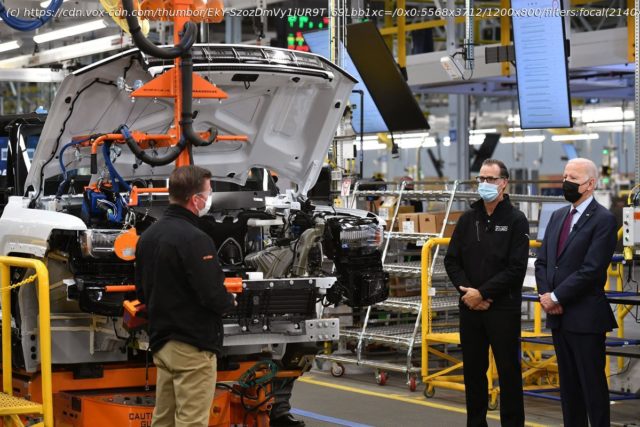The auto industry strike is one facet of the mounting tension between the energy transition and workers who could lose their jobs.
Auto unions and US carmakers recently smoothed over a huge pothole on the road to electric vehicles, but workers are facing much bigger ruts ahead on the route to clean energy.
In the past week, the United Auto Workers labor union reached tentative agreements with Ford, Stellantis, and GM, paving the road to ending their weeks-long strikes at the three largest US automakers.
One of the major concerns for the union was the shift toward electric vehicles. Car companies like Ford are betting big on electrification as a tactic to meet their climate change targets, but the UAW is concerned that new EV plants and battery factories could be used to replace union jobs with a non-unionized, lower-paid workforce. “We have been absolutely clear that the switch to electric engine jobs, battery production and other EV manufacturing cannot become a race to the bottom,” said UAW President Shawn Fain over the summer in a statement. The union also worries that EV production may lead to fewer workers overall.
So far, the UAW has secured an agreement with GM to bring battery manufacturing under its auto contract, allowing the union to negotiate wages and benefits for workers building the lithium ion batteries that power electric cars. The tentative agreement with Ford allows the union to go on strike if plants close, giving workers leverage as production lines for older fossil-fuel-powered vehicles shut down.
“It lays a foundation for UAW members to be making electric vehicles under UAW contracts into the future, which is enormously exciting and good for workers, not just in the auto sector, but across the economy given the size of the sector,” said Jason Walsh, executive director of the BlueGreen Alliance, a partnership of labor and environmental groups.
However, more friction points are likely to emerge in the coming years across industries. The US has committed to becoming carbon-neutral by 2050. Meeting that target will require a handbrake turn in how the country makes electricity, heats homes, powers vehicles, and runs assembly lines. And to navigate this hairpin curve, the US needs a massive workforce to research, develop, build, install, and maintain the low-carbon technologies of the future.
At the same time, this transition will also require moving away from fossil fuels. The US energy sector employed 8.1 million people in 2022, according to the US Department of Energy. About 1.7 million jobs belonged to people working directly in coal, oil, and natural gas, while the Energy Department noted 3.1 million were employed in “clean” sectors including energy storage, efficiency, fuel cells, nuclear, and grid technologies. The auto industry is currently on both sides of this line, but eventually it will have to settle in the clean energy lane.
The government is already funding research and development, offering billions of dollars in grants, tax credits, and loan guarantees, and imposing regulations to spur this change. The Inflation Reduction Act included $400 billion to boost clean energy and address climate change. However, the UAW has criticized some of these programs for not securing wages and worker benefits.
For autoworkers, the fear is that their skills in milling engine blocks and assembling transmissions might not translate to winding electric motors or wiring high-voltage circuits.
Домой
United States
USA — Science Why more fossil fuel workers aren’t joining the clean energy revolution






